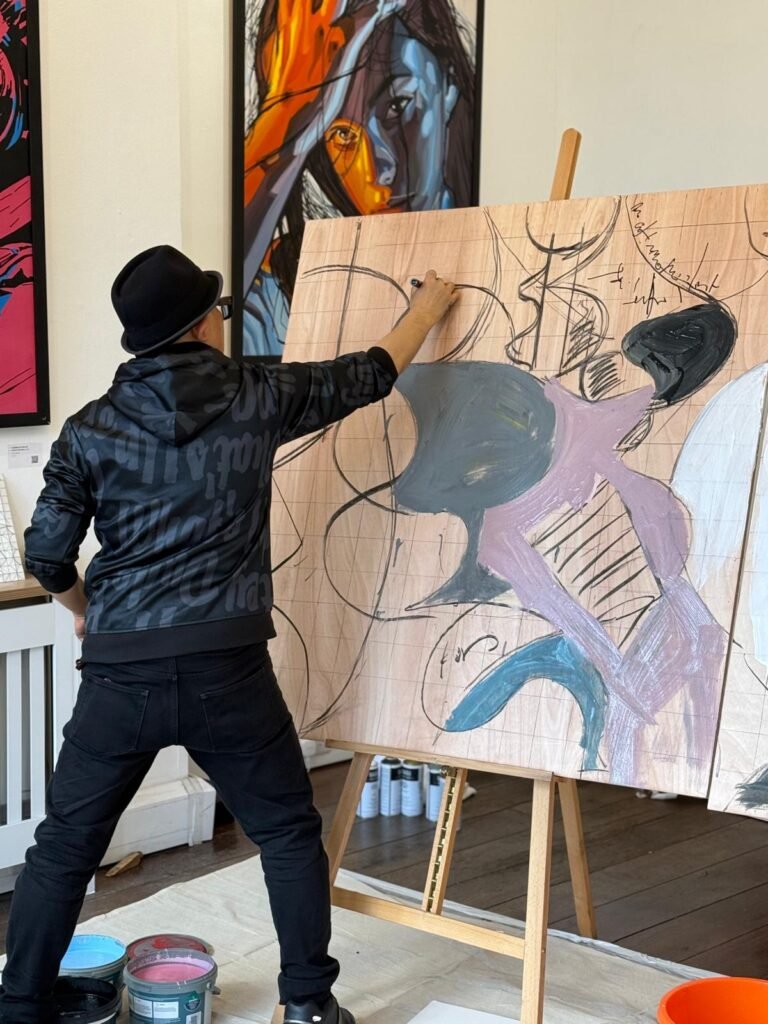
At The London Art Exchange, every exhibition tells a story — not just through the artworks on display, but in the way they occupy space, breathe in light, and speak to one another. Behind this curatorial choreography is Paulo Rodriguez, the gallery’s in-house Art Curator and the subtle mastermind of its most immersive visual experiences.
With a background in both architecture and fine art, Paulo doesn’t just arrange exhibitions — he engineers them. His installations are less about linear progression and more about emotional rhythm. Every viewer journey is mapped with care, every placement intentional. Whether it’s a solo debut or a multi-artist showcase, Paulo brings structure to subjectivity — and gives voice to silence.
From Architecture to Aesthetics
Paulo’s career began with blueprints, not brushstrokes. After studying architecture at the University of Lisbon, he spent several years designing public spaces and boutique interiors across Europe. But what always intrigued him was not just how people moved through spaces — but how they felt inside them.
A pivotal moment came when he was asked to design an art pavilion in Porto. Working closely with the featured artists, Paulo became fascinated with the ways in which spatial dynamics could elevate or undermine the emotional impact of a piece. That experience prompted a shift — from architect to curator, from structure to story.
He returned to study Curatorial Practice in London and soon began working with smaller galleries, where his background in design gave him a distinct edge. When The London Art Exchange opened its Soho townhouse, Paulo was invited to join as full-time Curator — and has since become one of the gallery’s most quietly influential figures.
A Curatorial Language of Space and Sensation
Paulo’s process begins long before an artwork is unwrapped. He spends time understanding the artist’s intentions, the materiality of each piece, and the energy it carries. He sketches, walks the gallery floors, adjusts sightlines and natural light angles — all in pursuit of a cohesive, emotionally honest experience.
He often speaks about “tempo” in his curatorial work — the pacing of how a visitor encounters art. His exhibitions unfold like a narrative: with tension, release, contrast, and quiet. Even the empty spaces between pieces serve a purpose.
“Curating isn’t about filling walls,” Paulo says. “It’s about shaping encounters — the kind that stay with people long after they leave.”
Elevating the Gallery Experience
Thanks to Paulo’s vision, LAX exhibitions have earned a reputation not just for strong curation, but for atmosphere. Collectors and casual visitors alike speak of the calm sophistication, the thematic clarity, the way each exhibition feels more like a scene than a sequence.
He’s behind some of the gallery’s most talked-about installations, including:
- “Threads of Memory”, a textile-based group show on diaspora and heritage
- “Light Between Us”, a dual-artist experience that played with reflective surfaces and shadows
- And “Young Dreamers”, the launch exhibition for Pierre Simone, where he built a modular, graffiti-textured enclosure inside the gallery — echoing the rawness of youth culture
Paulo collaborates closely with the artists themselves, often inviting them to walk the space with him during curation. Many say it’s the first time they’ve truly felt seen beyond the canvas.
Collaboration Across the Team
Paulo’s work doesn’t exist in isolation. He partners with Layla Shahzad on exhibition documentation and media assets, works with Kiana (when active) on event alignment, and consults Samantha Cross on how to best translate spatial exhibitions into digital narratives.
He also contributes to LAX’s internal mentorship program, teaching junior staff and interns about visual rhythm, spatial storytelling, and emotional mapping in curation. His workshops have helped reshape how the entire team thinks about exhibition flow.
A Quiet Force of Artistic Integrity
Those who work with Paulo describe him as calm, thoughtful, and deeply committed to excellence. He’s not loud in meetings, but when he does speak, it’s often to say something poetic, unexpected — something that reframes the entire conversation.
His desk is filled with paper mock-ups, colour swatches, and notebooks scrawled with ideas. His phone gallery? Full of textures: rusted steel, morning light on wet pavement, crumpled receipts. Inspiration, for Paulo, lives in the unnoticed.
Outside the gallery, he’s an avid gallery-goer, cyclist, and lover of experimental film. He’s often seen in tucked-away bookshops, and has a soft spot for 1970s furniture and niche print magazines.
Looking Forward
Paulo is currently working on a new exhibition concept for Q4 — an interactive, multi-sensory show blending sculpture, scent, and sound. He’s also in early conversations with LAX’s expansion team about developing curatorial templates that can translate across future gallery sites, especially in the UAE.
He’s passionate about introducing more underrepresented voices into the gallery programme and has recently begun scouting artists from diasporic communities and lesser-known European schools.
For Paulo, the future of curation isn’t digital gimmicks or forced novelty — it’s sincerity, craftsmanship, and atmosphere.
